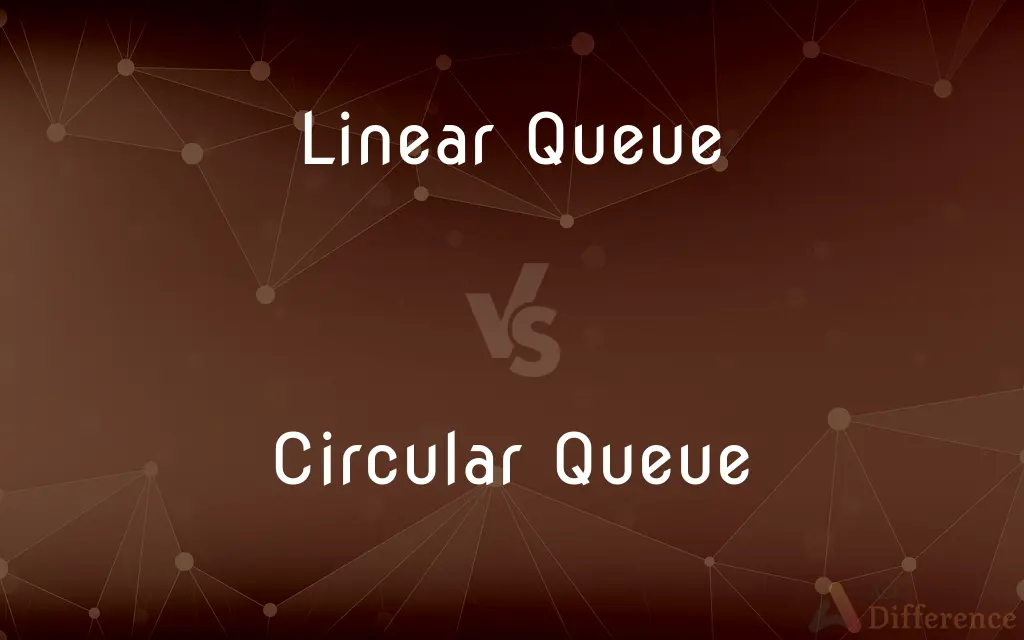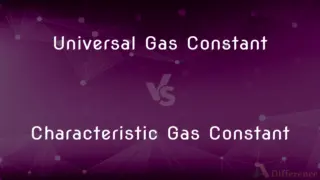Linear Queue vs. Circular Queue — What's the Difference?
By Tayyaba Rehman & Fiza Rafique — Published on January 30, 2024
A Linear Queue is a data structure where elements are added at the rear and removed from the front in a first-in-first-out manner; a Circular Queue is a type of linear queue but is circular in nature, allowing for the efficient reuse of queue space.

Difference Between Linear Queue and Circular Queue
Table of Contents
ADVERTISEMENT
Key Differences
Linear Queue operates on the principle of first-in-first-out (FIFO), where elements are added (enqueued) at the rear and removed (dequeued) from the front. Circular Queue, while also following FIFO, connects the end of the queue to the front, forming a circle, which optimizes the use of memory space.
In a Linear Queue, once an element is dequeued from the front, that space cannot be reused, potentially leading to inefficient use of memory if not managed properly. In contrast, a Circular Queue allows the reuse of space; after reaching the end of the queue, new elements can be added at the beginning if there is free space.
Linear Queues are simpler in implementation but can lead to the problem of "queue overflow" even if there is space at the front of the queue due to its strict linear structure. Circular Queues overcome this limitation by connecting the end to the front, making it a more efficient option for continuous data processing.
In a Linear Queue, tracking elements involves monitoring just the front and rear positions. However, in a Circular Queue, additional logic is required to determine whether the queue is full or empty and to manage the circular movement of the queue pointers.
Linear Queues are often used in scenarios where data is processed once and does not need to be revisited. Circular Queues are preferred in applications like buffering, where a fixed amount of space is continuously reused for data storage and retrieval.
ADVERTISEMENT
Comparison Chart
Structure
Straight line, with a distinct front and rear
Circular, connecting rear back to front
Memory Utilization
Inefficient, as dequeued spaces are not reused
Efficient, as spaces can be reused
Overflow Handling
Can experience overflow despite free space at the front
Less prone to overflow due to circular nature
Implementation Complexity
Simpler, with basic enqueue and dequeue operations
More complex due to circular logic
Typical Use Cases
Suitable for one-time processed data
Ideal for continuous data processing, like buffering
Compare with Definitions
Linear Queue
Linear Queue is best suited for one-time data processing applications.
The ticket counter uses a linear queue to serve customers.
Circular Queue
Circular Queue optimizes memory usage by eliminating wasted space.
The circular event log queue overwrites old entries with new ones, saving memory.
Linear Queue
Linear Queue does not allow the reuse of space after dequeuing.
In a linear queue of a call center, once a call is handled, that space in the queue is not immediately reusable.
Circular Queue
Circular Queue is ideal for repeated data processing like buffering.
In video games, input commands are often handled using a circular queue.
Linear Queue
A Linear Queue is a sequential data structure following FIFO.
The printer queue is a linear queue, processing print jobs in the order they are received.
Circular Queue
A Circular Queue is a linear queue structured in a circular form.
The buffer in a streaming application is managed as a circular queue.
Linear Queue
In a Linear Queue, elements are enqueued at the rear and dequeued from the front.
Customers waiting in line at a bank form a linear queue.
Circular Queue
In a Circular Queue, space freed from dequeuing can be reused.
The circular queue in the traffic light system efficiently reuses slots for incoming traffic data.
Linear Queue
Linear Queue is simpler but can suffer from inefficient memory usage.
The server's request handling queue is linear, leading to potential memory wastage.
Circular Queue
Circular Queue requires more complex management than a linear queue.
Implementing a circular queue for process scheduling required careful programming to handle wrap-around.
Common Curiosities
Can elements be inserted at any position in a Circular Queue?
No, elements can only be inserted at the rear (end) of a Circular Queue.
Can elements be removed from any position in a Circular Queue?
No, elements can only be removed from the front (beginning) of a Circular Queue.
How do you detect whether a Circular Queue is empty or full?
By checking if the front and rear pointers are equal (empty) or differ by one position (full) in the Circular Queue.
What is the primary advantage of a Circular Queue over a Linear Queue?
Circular Queues efficiently utilize memory and allow continuous operation even after reaching full capacity.
Can elements be inserted at any position in a Linear Queue?
No, elements can only be inserted at the rear (end) of a Linear Queue.
What is a Linear Queue?
A data structure where elements are added at the rear and removed from the front in FIFO order.
What defines a Circular Queue?
A queue arranged in a circle, allowing for efficient reuse of space.
What is the maximum capacity of a Linear Queue implemented using an array?
The maximum capacity of a Linear Queue implemented using an array is limited by the size of the array.
What happens when a Linear Queue becomes full?
When a Linear Queue is full, it cannot accept any more elements, and any attempt to enqueue (insert) a new element will result in an overflow.
What happens when a Linear Queue becomes empty?
When a Linear Queue is empty, it cannot provide any elements for dequeuing (removing), and any attempt to dequeue an element will result in underflow.
Can elements be removed from any position in a Linear Queue?
No, elements can only be removed from the front (beginning) of a Linear Queue.
What is the primary advantage of a Linear Queue over other data structures?
Linear Queues are simple to implement and follow a straightforward FIFO behavior.
Is it possible to implement a priority queue using a Linear Queue?
Yes, a priority queue can be implemented using a Linear Queue by assigning priority values to elements.
Share Your Discovery

Previous Comparison
Universal Gas Constant vs. Characteristic Gas Constant
Next Comparison
Kinetochore Microtubules vs. Nonkinetochore MicrotubulesAuthor Spotlight
Written by
Tayyaba RehmanTayyaba Rehman is a distinguished writer, currently serving as a primary contributor to askdifference.com. As a researcher in semantics and etymology, Tayyaba's passion for the complexity of languages and their distinctions has found a perfect home on the platform. Tayyaba delves into the intricacies of language, distinguishing between commonly confused words and phrases, thereby providing clarity for readers worldwide.
Co-written by
Fiza RafiqueFiza Rafique is a skilled content writer at AskDifference.com, where she meticulously refines and enhances written pieces. Drawing from her vast editorial expertise, Fiza ensures clarity, accuracy, and precision in every article. Passionate about language, she continually seeks to elevate the quality of content for readers worldwide.
















































